Reflective Journal on Shared Value and Open Innovation Concepts
VerifiedAdded on 2023/03/23
|6
|1324
|29
Journal and Reflective Writing
AI Summary
This reflective journal delves into the concept of creating shared value, emphasizing its role in enhancing organizational success and addressing social and environmental issues. It highlights the framework introduced by Michael Porter and Mark Kramer, which encourages businesses to identify and capitalize on social problems for mutual financial and societal benefit. The journal contrasts shared value with corporate social responsibility (CSR), noting that shared value integrates social considerations into core business strategies rather than treating them as separate philanthropic endeavors. It further explores how shared value can be created through reconceiving products and markets, redefining productivity in the value chain, and enabling local cluster development. The importance of open innovation, teamwork, and collaboration in achieving shared value goals is also discussed. The journal concludes that embracing shared value and open innovation is crucial for the future of organizations, promoting sustainable practices and contributing to societal progress.
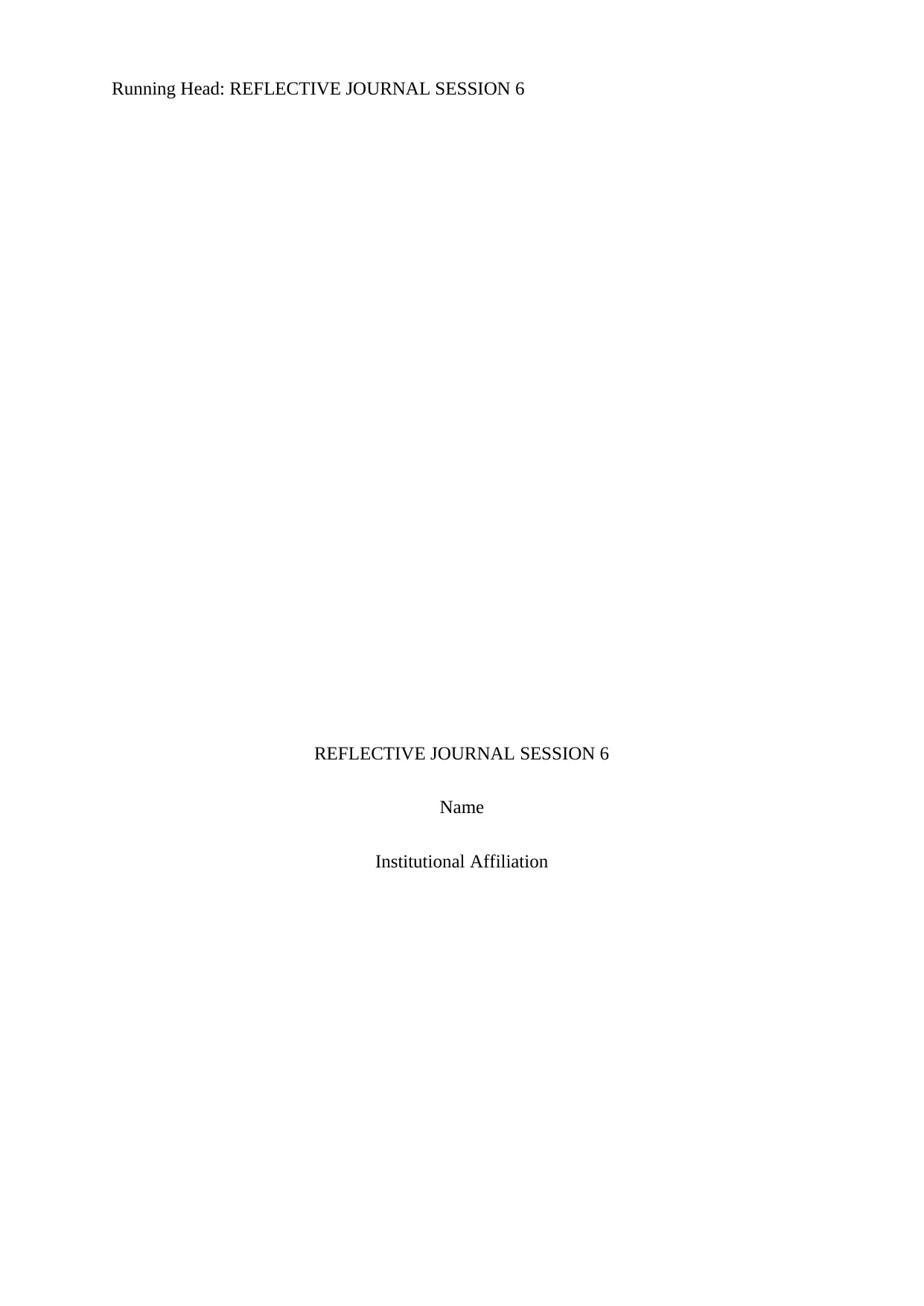
Running Head: REFLECTIVE JOURNAL SESSION 6
REFLECTIVE JOURNAL SESSION 6
Name
Institutional Affiliation
REFLECTIVE JOURNAL SESSION 6
Name
Institutional Affiliation
Paraphrase This Document
Need a fresh take? Get an instant paraphrase of this document with our AI Paraphraser
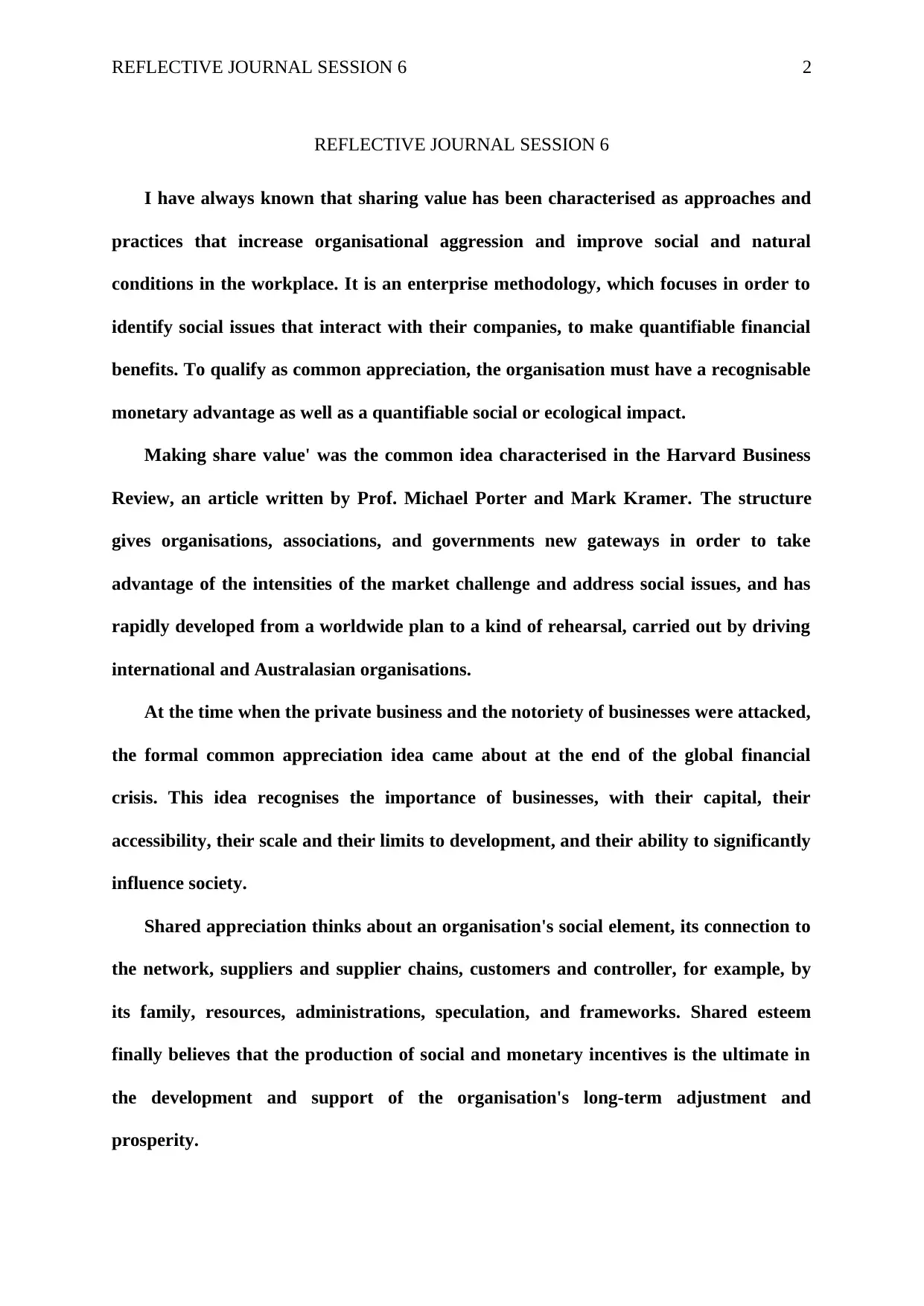
REFLECTIVE JOURNAL SESSION 6 2
REFLECTIVE JOURNAL SESSION 6
I have always known that sharing value has been characterised as approaches and
practices that increase organisational aggression and improve social and natural
conditions in the workplace. It is an enterprise methodology, which focuses in order to
identify social issues that interact with their companies, to make quantifiable financial
benefits. To qualify as common appreciation, the organisation must have a recognisable
monetary advantage as well as a quantifiable social or ecological impact.
Making share value' was the common idea characterised in the Harvard Business
Review, an article written by Prof. Michael Porter and Mark Kramer. The structure
gives organisations, associations, and governments new gateways in order to take
advantage of the intensities of the market challenge and address social issues, and has
rapidly developed from a worldwide plan to a kind of rehearsal, carried out by driving
international and Australasian organisations.
At the time when the private business and the notoriety of businesses were attacked,
the formal common appreciation idea came about at the end of the global financial
crisis. This idea recognises the importance of businesses, with their capital, their
accessibility, their scale and their limits to development, and their ability to significantly
influence society.
Shared appreciation thinks about an organisation's social element, its connection to
the network, suppliers and supplier chains, customers and controller, for example, by
its family, resources, administrations, speculation, and frameworks. Shared esteem
finally believes that the production of social and monetary incentives is the ultimate in
the development and support of the organisation's long-term adjustment and
prosperity.
REFLECTIVE JOURNAL SESSION 6
I have always known that sharing value has been characterised as approaches and
practices that increase organisational aggression and improve social and natural
conditions in the workplace. It is an enterprise methodology, which focuses in order to
identify social issues that interact with their companies, to make quantifiable financial
benefits. To qualify as common appreciation, the organisation must have a recognisable
monetary advantage as well as a quantifiable social or ecological impact.
Making share value' was the common idea characterised in the Harvard Business
Review, an article written by Prof. Michael Porter and Mark Kramer. The structure
gives organisations, associations, and governments new gateways in order to take
advantage of the intensities of the market challenge and address social issues, and has
rapidly developed from a worldwide plan to a kind of rehearsal, carried out by driving
international and Australasian organisations.
At the time when the private business and the notoriety of businesses were attacked,
the formal common appreciation idea came about at the end of the global financial
crisis. This idea recognises the importance of businesses, with their capital, their
accessibility, their scale and their limits to development, and their ability to significantly
influence society.
Shared appreciation thinks about an organisation's social element, its connection to
the network, suppliers and supplier chains, customers and controller, for example, by
its family, resources, administrations, speculation, and frameworks. Shared esteem
finally believes that the production of social and monetary incentives is the ultimate in
the development and support of the organisation's long-term adjustment and
prosperity.
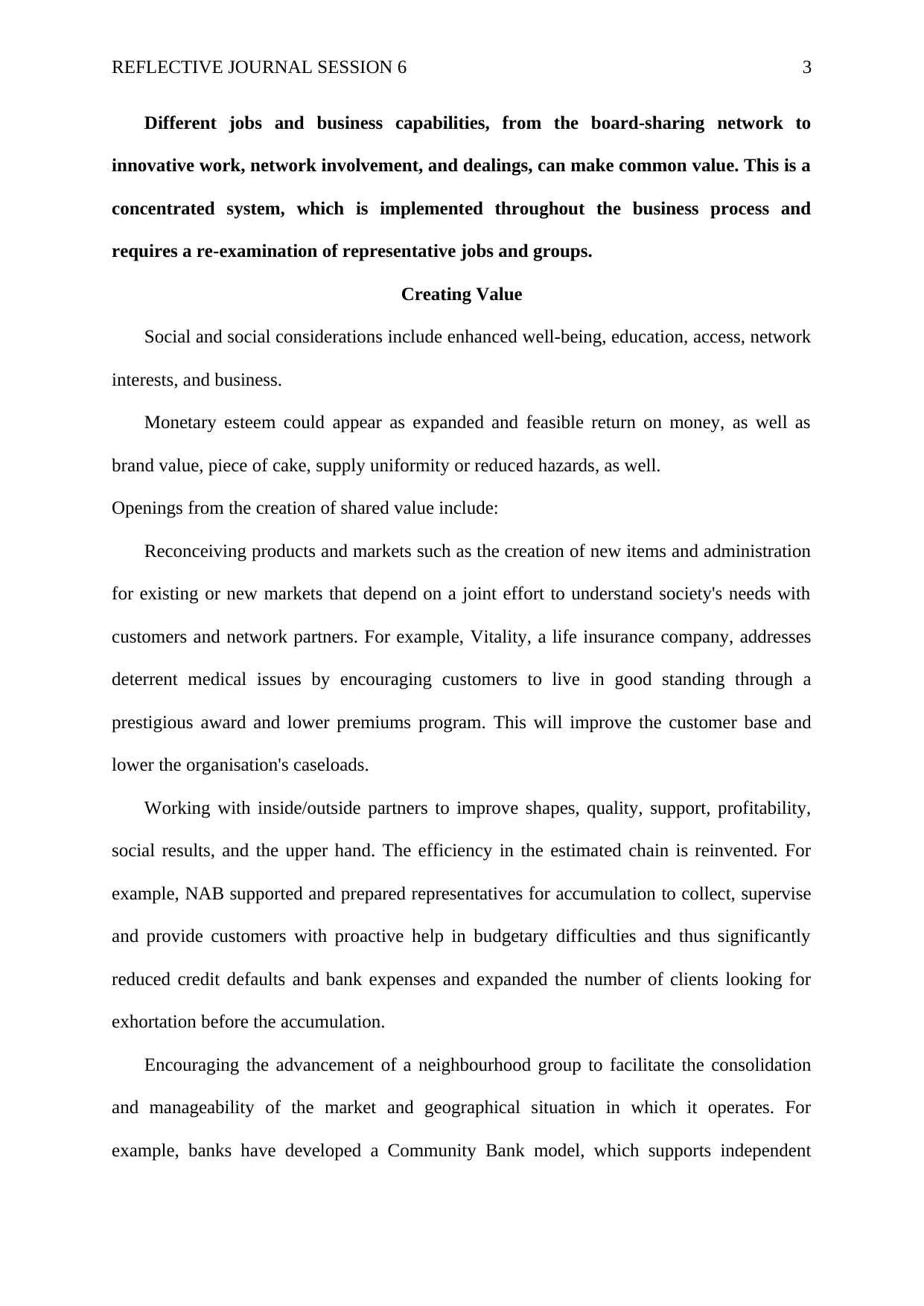
REFLECTIVE JOURNAL SESSION 6 3
Different jobs and business capabilities, from the board-sharing network to
innovative work, network involvement, and dealings, can make common value. This is a
concentrated system, which is implemented throughout the business process and
requires a re-examination of representative jobs and groups.
Creating Value
Social and social considerations include enhanced well-being, education, access, network
interests, and business.
Monetary esteem could appear as expanded and feasible return on money, as well as
brand value, piece of cake, supply uniformity or reduced hazards, as well.
Openings from the creation of shared value include:
Reconceiving products and markets such as the creation of new items and administration
for existing or new markets that depend on a joint effort to understand society's needs with
customers and network partners. For example, Vitality, a life insurance company, addresses
deterrent medical issues by encouraging customers to live in good standing through a
prestigious award and lower premiums program. This will improve the customer base and
lower the organisation's caseloads.
Working with inside/outside partners to improve shapes, quality, support, profitability,
social results, and the upper hand. The efficiency in the estimated chain is reinvented. For
example, NAB supported and prepared representatives for accumulation to collect, supervise
and provide customers with proactive help in budgetary difficulties and thus significantly
reduced credit defaults and bank expenses and expanded the number of clients looking for
exhortation before the accumulation.
Encouraging the advancement of a neighbourhood group to facilitate the consolidation
and manageability of the market and geographical situation in which it operates. For
example, banks have developed a Community Bank model, which supports independent
Different jobs and business capabilities, from the board-sharing network to
innovative work, network involvement, and dealings, can make common value. This is a
concentrated system, which is implemented throughout the business process and
requires a re-examination of representative jobs and groups.
Creating Value
Social and social considerations include enhanced well-being, education, access, network
interests, and business.
Monetary esteem could appear as expanded and feasible return on money, as well as
brand value, piece of cake, supply uniformity or reduced hazards, as well.
Openings from the creation of shared value include:
Reconceiving products and markets such as the creation of new items and administration
for existing or new markets that depend on a joint effort to understand society's needs with
customers and network partners. For example, Vitality, a life insurance company, addresses
deterrent medical issues by encouraging customers to live in good standing through a
prestigious award and lower premiums program. This will improve the customer base and
lower the organisation's caseloads.
Working with inside/outside partners to improve shapes, quality, support, profitability,
social results, and the upper hand. The efficiency in the estimated chain is reinvented. For
example, NAB supported and prepared representatives for accumulation to collect, supervise
and provide customers with proactive help in budgetary difficulties and thus significantly
reduced credit defaults and bank expenses and expanded the number of clients looking for
exhortation before the accumulation.
Encouraging the advancement of a neighbourhood group to facilitate the consolidation
and manageability of the market and geographical situation in which it operates. For
example, banks have developed a Community Bank model, which supports independent
⊘ This is a preview!⊘
Do you want full access?
Subscribe today to unlock all pages.

Trusted by 1+ million students worldwide
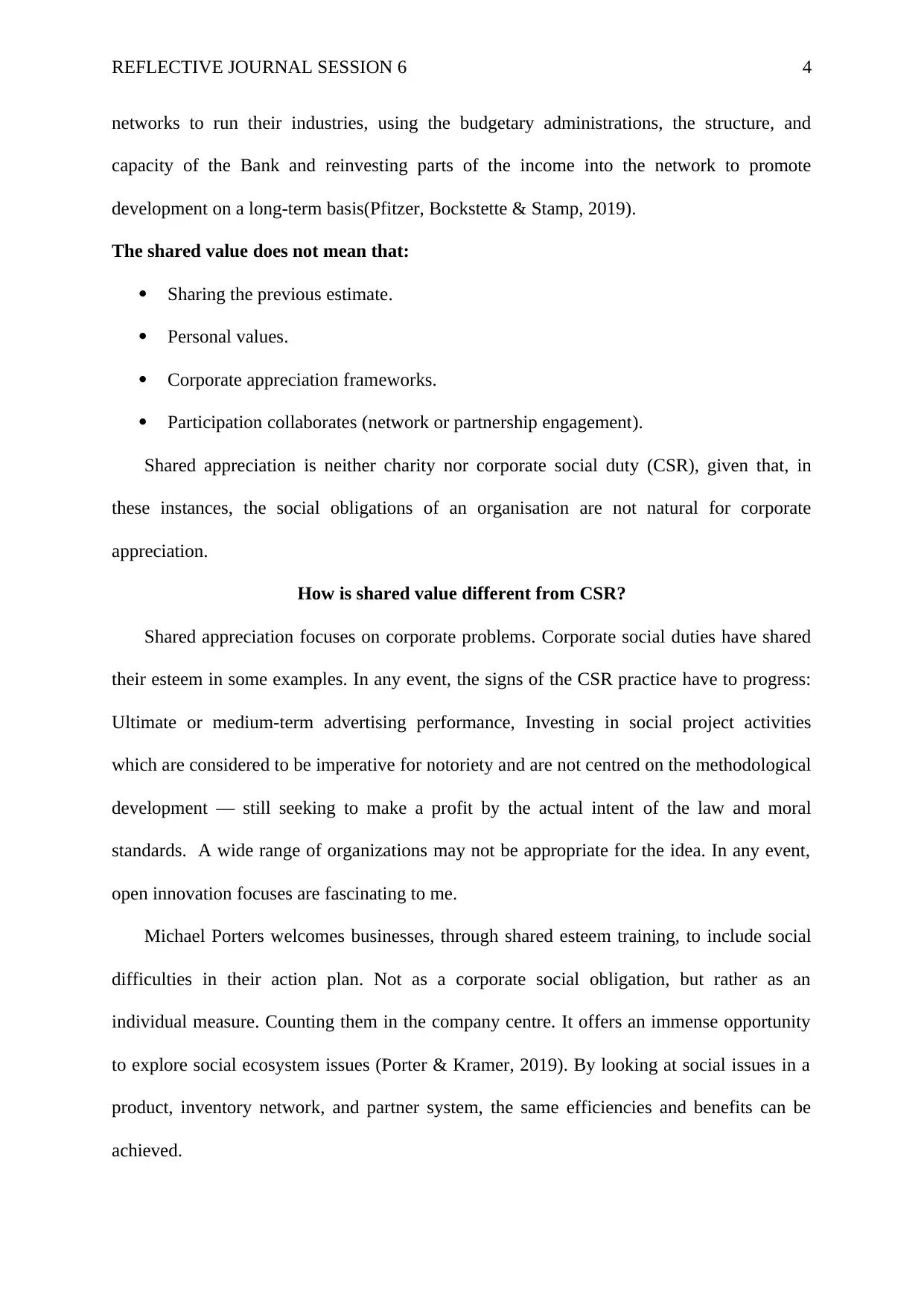
REFLECTIVE JOURNAL SESSION 6 4
networks to run their industries, using the budgetary administrations, the structure, and
capacity of the Bank and reinvesting parts of the income into the network to promote
development on a long-term basis(Pfitzer, Bockstette & Stamp, 2019).
The shared value does not mean that:
Sharing the previous estimate.
Personal values.
Corporate appreciation frameworks.
Participation collaborates (network or partnership engagement).
Shared appreciation is neither charity nor corporate social duty (CSR), given that, in
these instances, the social obligations of an organisation are not natural for corporate
appreciation.
How is shared value different from CSR?
Shared appreciation focuses on corporate problems. Corporate social duties have shared
their esteem in some examples. In any event, the signs of the CSR practice have to progress:
Ultimate or medium-term advertising performance, Investing in social project activities
which are considered to be imperative for notoriety and are not centred on the methodological
development — still seeking to make a profit by the actual intent of the law and moral
standards. A wide range of organizations may not be appropriate for the idea. In any event,
open innovation focuses are fascinating to me.
Michael Porters welcomes businesses, through shared esteem training, to include social
difficulties in their action plan. Not as a corporate social obligation, but rather as an
individual measure. Counting them in the company centre. It offers an immense opportunity
to explore social ecosystem issues (Porter & Kramer, 2019). By looking at social issues in a
product, inventory network, and partner system, the same efficiencies and benefits can be
achieved.
networks to run their industries, using the budgetary administrations, the structure, and
capacity of the Bank and reinvesting parts of the income into the network to promote
development on a long-term basis(Pfitzer, Bockstette & Stamp, 2019).
The shared value does not mean that:
Sharing the previous estimate.
Personal values.
Corporate appreciation frameworks.
Participation collaborates (network or partnership engagement).
Shared appreciation is neither charity nor corporate social duty (CSR), given that, in
these instances, the social obligations of an organisation are not natural for corporate
appreciation.
How is shared value different from CSR?
Shared appreciation focuses on corporate problems. Corporate social duties have shared
their esteem in some examples. In any event, the signs of the CSR practice have to progress:
Ultimate or medium-term advertising performance, Investing in social project activities
which are considered to be imperative for notoriety and are not centred on the methodological
development — still seeking to make a profit by the actual intent of the law and moral
standards. A wide range of organizations may not be appropriate for the idea. In any event,
open innovation focuses are fascinating to me.
Michael Porters welcomes businesses, through shared esteem training, to include social
difficulties in their action plan. Not as a corporate social obligation, but rather as an
individual measure. Counting them in the company centre. It offers an immense opportunity
to explore social ecosystem issues (Porter & Kramer, 2019). By looking at social issues in a
product, inventory network, and partner system, the same efficiencies and benefits can be
achieved.
Paraphrase This Document
Need a fresh take? Get an instant paraphrase of this document with our AI Paraphraser
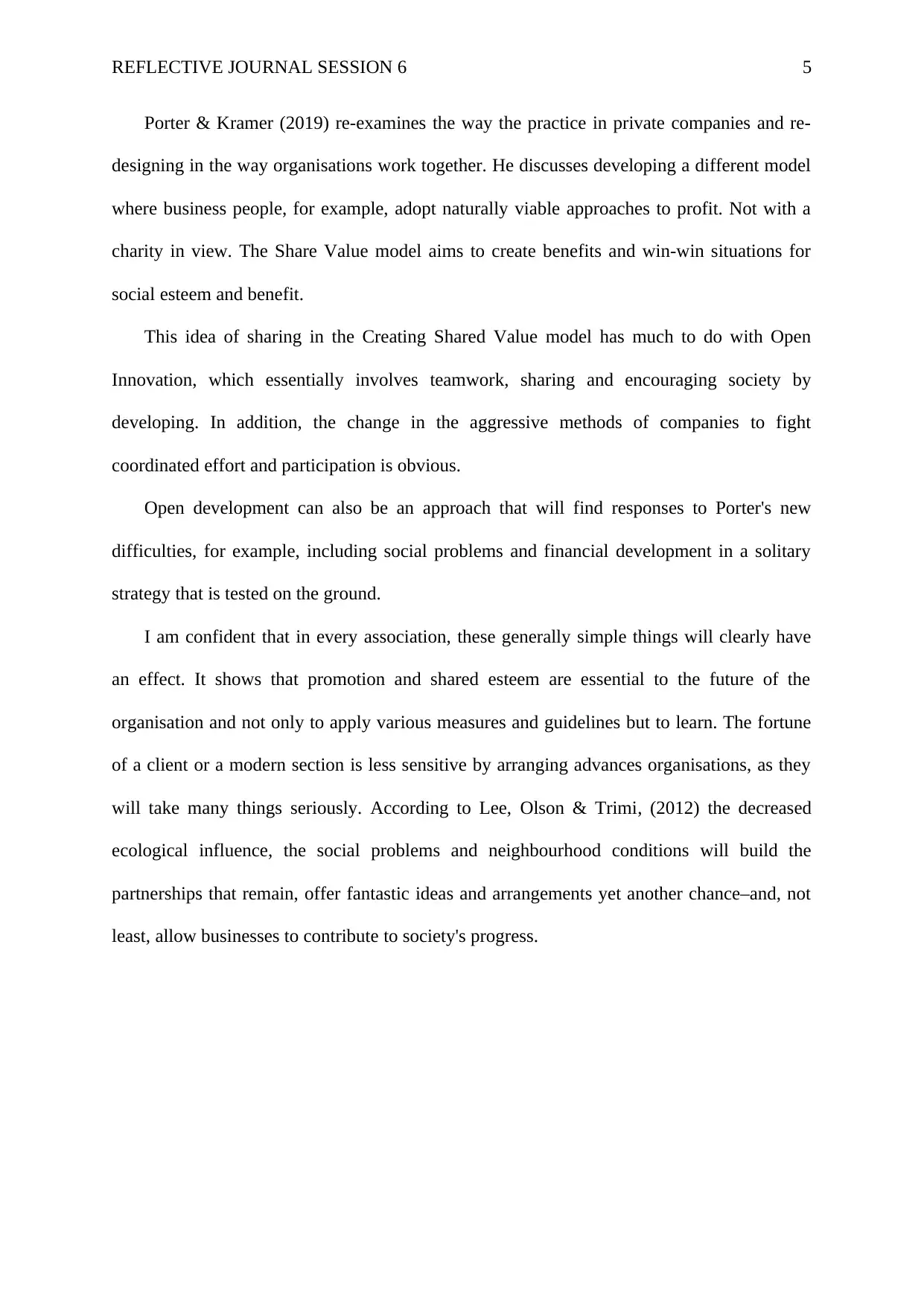
REFLECTIVE JOURNAL SESSION 6 5
Porter & Kramer (2019) re-examines the way the practice in private companies and re-
designing in the way organisations work together. He discusses developing a different model
where business people, for example, adopt naturally viable approaches to profit. Not with a
charity in view. The Share Value model aims to create benefits and win-win situations for
social esteem and benefit.
This idea of sharing in the Creating Shared Value model has much to do with Open
Innovation, which essentially involves teamwork, sharing and encouraging society by
developing. In addition, the change in the aggressive methods of companies to fight
coordinated effort and participation is obvious.
Open development can also be an approach that will find responses to Porter's new
difficulties, for example, including social problems and financial development in a solitary
strategy that is tested on the ground.
I am confident that in every association, these generally simple things will clearly have
an effect. It shows that promotion and shared esteem are essential to the future of the
organisation and not only to apply various measures and guidelines but to learn. The fortune
of a client or a modern section is less sensitive by arranging advances organisations, as they
will take many things seriously. According to Lee, Olson & Trimi, (2012) the decreased
ecological influence, the social problems and neighbourhood conditions will build the
partnerships that remain, offer fantastic ideas and arrangements yet another chance–and, not
least, allow businesses to contribute to society's progress.
Porter & Kramer (2019) re-examines the way the practice in private companies and re-
designing in the way organisations work together. He discusses developing a different model
where business people, for example, adopt naturally viable approaches to profit. Not with a
charity in view. The Share Value model aims to create benefits and win-win situations for
social esteem and benefit.
This idea of sharing in the Creating Shared Value model has much to do with Open
Innovation, which essentially involves teamwork, sharing and encouraging society by
developing. In addition, the change in the aggressive methods of companies to fight
coordinated effort and participation is obvious.
Open development can also be an approach that will find responses to Porter's new
difficulties, for example, including social problems and financial development in a solitary
strategy that is tested on the ground.
I am confident that in every association, these generally simple things will clearly have
an effect. It shows that promotion and shared esteem are essential to the future of the
organisation and not only to apply various measures and guidelines but to learn. The fortune
of a client or a modern section is less sensitive by arranging advances organisations, as they
will take many things seriously. According to Lee, Olson & Trimi, (2012) the decreased
ecological influence, the social problems and neighbourhood conditions will build the
partnerships that remain, offer fantastic ideas and arrangements yet another chance–and, not
least, allow businesses to contribute to society's progress.
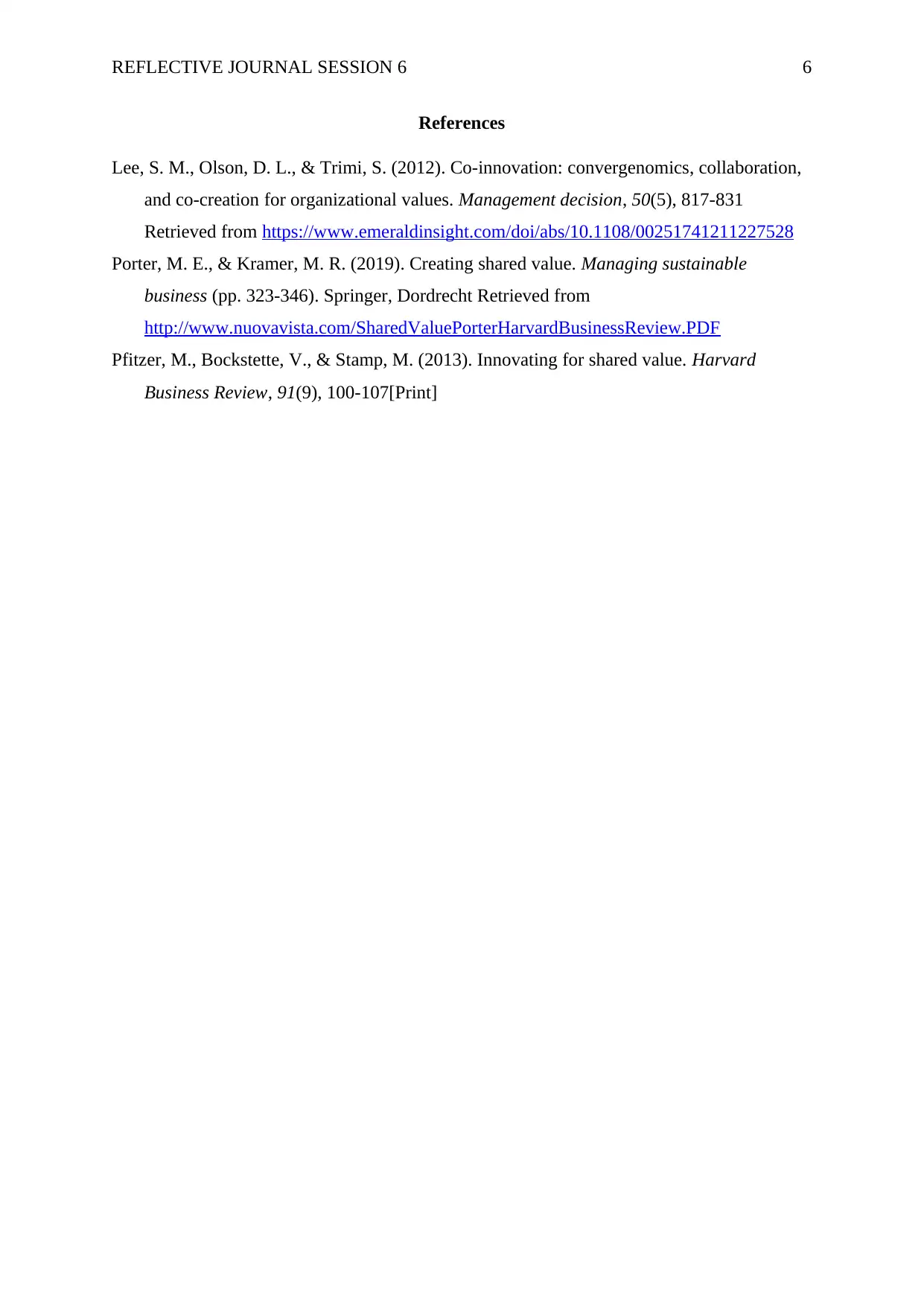
REFLECTIVE JOURNAL SESSION 6 6
References
Lee, S. M., Olson, D. L., & Trimi, S. (2012). Co-innovation: convergenomics, collaboration,
and co-creation for organizational values. Management decision, 50(5), 817-831
Retrieved from https://www.emeraldinsight.com/doi/abs/10.1108/00251741211227528
Porter, M. E., & Kramer, M. R. (2019). Creating shared value. Managing sustainable
business (pp. 323-346). Springer, Dordrecht Retrieved from
http://www.nuovavista.com/SharedValuePorterHarvardBusinessReview.PDF
Pfitzer, M., Bockstette, V., & Stamp, M. (2013). Innovating for shared value. Harvard
Business Review, 91(9), 100-107[Print]
References
Lee, S. M., Olson, D. L., & Trimi, S. (2012). Co-innovation: convergenomics, collaboration,
and co-creation for organizational values. Management decision, 50(5), 817-831
Retrieved from https://www.emeraldinsight.com/doi/abs/10.1108/00251741211227528
Porter, M. E., & Kramer, M. R. (2019). Creating shared value. Managing sustainable
business (pp. 323-346). Springer, Dordrecht Retrieved from
http://www.nuovavista.com/SharedValuePorterHarvardBusinessReview.PDF
Pfitzer, M., Bockstette, V., & Stamp, M. (2013). Innovating for shared value. Harvard
Business Review, 91(9), 100-107[Print]
⊘ This is a preview!⊘
Do you want full access?
Subscribe today to unlock all pages.

Trusted by 1+ million students worldwide
1 out of 6
Related Documents
Your All-in-One AI-Powered Toolkit for Academic Success.
+13062052269
info@desklib.com
Available 24*7 on WhatsApp / Email
![[object Object]](/_next/static/media/star-bottom.7253800d.svg)
Unlock your academic potential
Copyright © 2020–2025 A2Z Services. All Rights Reserved. Developed and managed by ZUCOL.





